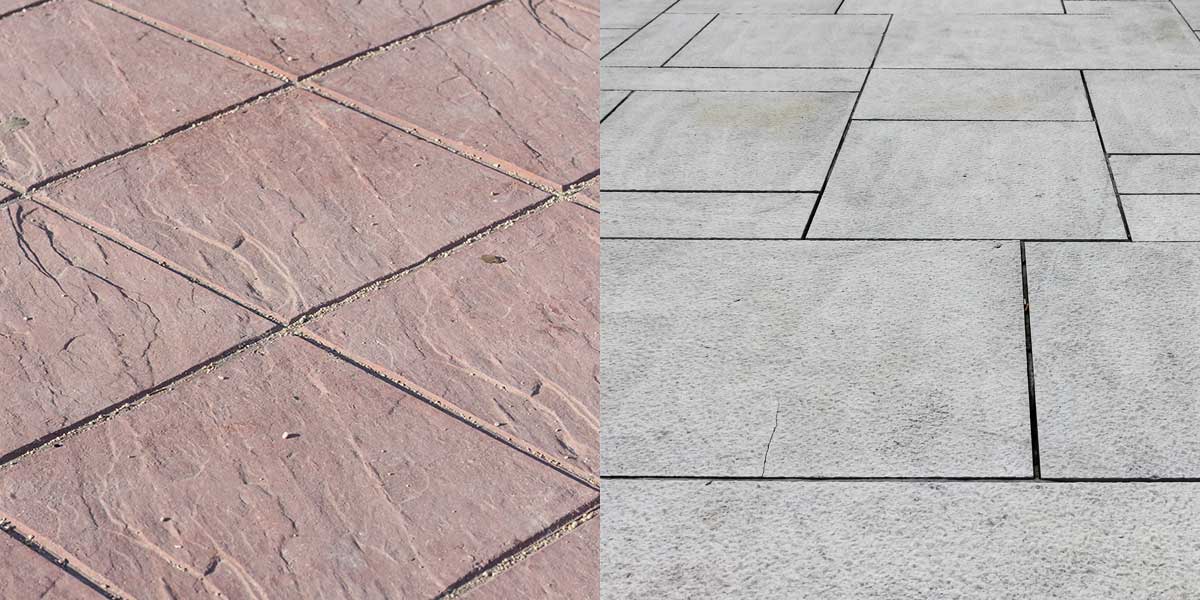When embarking on an exterior home improvement project, one critical aspect to consider is the choice between stamped concrete and pavers. Both options carry their own sets of advantages and disadvantages, including differences in cost, durability, and aesthetic appeal.
This comprehensive guide will examine the pros and cons of each, highlighting the cost of stamped concrete vs. pavers to enable you to make an informed decision that best suits your outdoor space.
Stamped Concrete: An Overview
Let’s start by familiarizing ourselves with the first option: stamped concrete. Stamped concrete is essentially poured concrete that has been imprinted or “stamped” to mimic the texture and pattern of other materials like brick, slate, flagstone, or wood.
Cost of Stamped Concrete vs. Pavers
Investing in stamped concrete typically costs anywhere between $8 to $20 per square foot. This price range accounts for factors such as the complexity of the design, color, and labor costs.
Although this initial cost may seem steep, it’s worth noting that stamped concrete can prove cost-effective in the long run, given its durability and low maintenance needs.
Pavers: An Overview
On the other hand, pavers are individual pieces made from various materials like concrete, stone, or brick. They are arranged in an interlocking pattern to create patios, driveways, and walkways.
Cost of Pavers
Pavers usually range in price from $10 to $25 per square foot, depending on the material used. For example, concrete pavers will typically be less expensive than stone pavers. Despite a potentially higher upfront cost, pavers offer longevity and easy repair, making them a worthwhile investment for many homeowners.
Durability and Maintenance: Stamped Concrete vs. Pavers
In terms of durability, both stamped concrete and pavers excel, albeit in different ways.
Stamped concrete is generally more resistant to heavy loads and pressure, making it an excellent choice for driveways or high-traffic areas. However, it may develop cracks over time, especially in regions with significant temperature fluctuations.
When handled by professional pavers installers, pavers are highly durable and can withstand varying weather conditions without cracking. Any damaged pavers can be easily replaced without affecting the rest of the structure.
Maintenance requirements differ as well. Stamped concrete requires regular sealing to maintain its color and protect it from wear and tear. Pavers, however, only require occasional replacement of sand between the joints and rare sealing.
Aesthetic Appeal: Stamped Concrete vs. Pavers
Aesthetically, both stamped concrete and pavers offer a wide array of design options.
Stamped concrete provides a seamless, uniform look, with the ability to mimic high-end materials at a fraction of the cost. However, its aesthetic appeal might be compromised over time if cracks develop.
Pavers, on the other hand, offer a variety of shapes, colors, and textures for unique and customizable designs. Unlike stamped concrete, pavers don’t crack, ensuring a consistently appealing look for years to come.
Installation: Stamped Concrete vs. Pavers
In terms of installation, stamped concrete can be more labor-intensive due to the processes of mixing, pouring, and stamping. This can extend the installation time and increase labor costs.
Conversely, pavers can be installed relatively quickly and easily. Once the base is prepared, individual pavers can be laid out according to the chosen pattern. The ease of installation often results in lower labor costs.
Frequently Asked Questions
1. Can stamped concrete or pavers be installed over existing concrete?
Yes, both stamped concrete overlays and thin pavers can be installed over existing concrete, given the existing surface is in good condition.
2. What is more durable, stamped concrete or pavers?
Pavers tend to be more durable and resistant to cracking compared to stamped concrete, particularly in areas that experience frequent freeze-thaw cycles.
3. How often should stamped concrete be resealed?
Stamped concrete generally needs to be resealed every 2-3 years, depending on the wear and tear and the quality of the initial seal.
4. Can the color of stamped concrete or pavers fade over time?
Yes, both can fade over time due to weather exposure, but this can be mitigated with regular sealing for stamped concrete and selecting pavers with color throughout, not just on the surface.
5. Can pavers shift over time?
Yes, pavers can shift over time, especially if they are not properly installed or if the ground beneath them is not adequately prepared. However, this issue can be easily remedied as pavers can be individually adjusted or replaced.
Conclusion
When choosing between these two materials for your outdoor space, it’s essential to weigh the cost of stamped concrete vs. pavers, durability, aesthetics, installation process, and environmental impact. Each material has its unique benefits and drawbacks. While stamped concrete offers a cost-effective, durable, and seamless finish, pavers bring versatility, easy repair, and a more environmentally friendly choice.
Ultimately, the choice will depend on your personal preference, budget, and specific needs for your outdoor project. Embarking on your next outdoor project soon? Get inspired with these creative outdoor hardscape designs!

